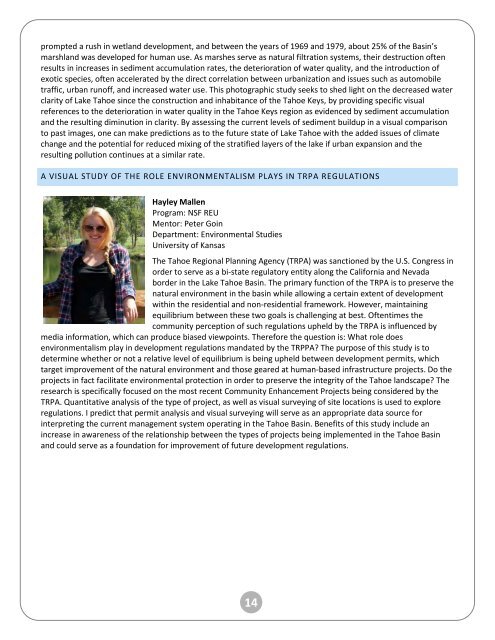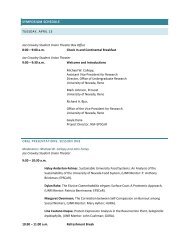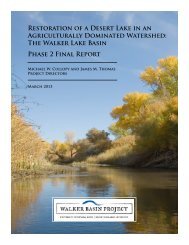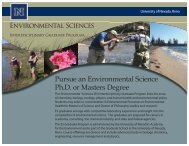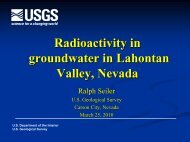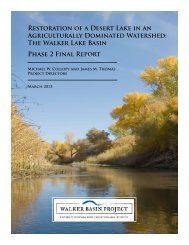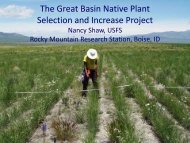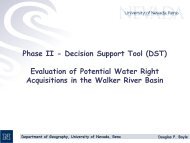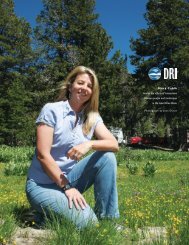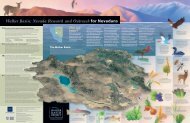Student Research Programs - Office of Undergraduate and ...
Student Research Programs - Office of Undergraduate and ...
Student Research Programs - Office of Undergraduate and ...
You also want an ePaper? Increase the reach of your titles
YUMPU automatically turns print PDFs into web optimized ePapers that Google loves.
prompted a rush in wetl<strong>and</strong> development, <strong>and</strong> between the years <strong>of</strong> 1969 <strong>and</strong> 1979, about 25% <strong>of</strong> the Basin’s<br />
marshl<strong>and</strong> was developed for human use. As marshes serve as natural filtration systems, their destruction <strong>of</strong>ten<br />
results in increases in sediment accumulation rates, the deterioration <strong>of</strong> water quality, <strong>and</strong> the introduction <strong>of</strong><br />
exotic species, <strong>of</strong>ten accelerated by the direct correlation between urbanization <strong>and</strong> issues such as automobile<br />
traffic, urban run<strong>of</strong>f, <strong>and</strong> increased water use. This photographic study seeks to shed light on the decreased water<br />
clarity <strong>of</strong> Lake Tahoe since the construction <strong>and</strong> inhabitance <strong>of</strong> the Tahoe Keys, by providing specific visual<br />
references to the deterioration in water quality in the Tahoe Keys region as evidenced by sediment accumulation<br />
<strong>and</strong> the resulting diminution in clarity. By assessing the current levels <strong>of</strong> sediment buildup in a visual comparison<br />
to past images, one can make predictions as to the future state <strong>of</strong> Lake Tahoe with the added issues <strong>of</strong> climate<br />
change <strong>and</strong> the potential for reduced mixing <strong>of</strong> the stratified layers <strong>of</strong> the lake if urban expansion <strong>and</strong> the<br />
resulting pollution continues at a similar rate.<br />
A VISUAL STUDY OF THE ROLE ENVIRONMENTALISM PLAYS IN TRPA REGULATIONS<br />
Hayley Mallen<br />
Program: NSF REU<br />
Mentor: Peter Goin<br />
Department: Environmental Studies<br />
University <strong>of</strong> Kansas<br />
The Tahoe Regional Planning Agency (TRPA) was sanctioned by the U.S. Congress in<br />
order to serve as a bi-state regulatory entity along the California <strong>and</strong> Nevada<br />
border in the Lake Tahoe Basin. The primary function <strong>of</strong> the TRPA is to preserve the<br />
natural environment in the basin while allowing a certain extent <strong>of</strong> development<br />
within the residential <strong>and</strong> non-residential framework. However, maintaining<br />
equilibrium between these two goals is challenging at best. Oftentimes the<br />
community perception <strong>of</strong> such regulations upheld by the TRPA is influenced by<br />
media information, which can produce biased viewpoints. Therefore the question is: What role does<br />
environmentalism play in development regulations m<strong>and</strong>ated by the TRPPA The purpose <strong>of</strong> this study is to<br />
determine whether or not a relative level <strong>of</strong> equilibrium is being upheld between development permits, which<br />
target improvement <strong>of</strong> the natural environment <strong>and</strong> those geared at human-based infrastructure projects. Do the<br />
projects in fact facilitate environmental protection in order to preserve the integrity <strong>of</strong> the Tahoe l<strong>and</strong>scape The<br />
research is specifically focused on the most recent Community Enhancement Projects being considered by the<br />
TRPA. Quantitative analysis <strong>of</strong> the type <strong>of</strong> project, as well as visual surveying <strong>of</strong> site locations is used to explore<br />
regulations. I predict that permit analysis <strong>and</strong> visual surveying will serve as an appropriate data source for<br />
interpreting the current management system operating in the Tahoe Basin. Benefits <strong>of</strong> this study include an<br />
increase in awareness <strong>of</strong> the relationship between the types <strong>of</strong> projects being implemented in the Tahoe Basin<br />
<strong>and</strong> could serve as a foundation for improvement <strong>of</strong> future development regulations.<br />
14


